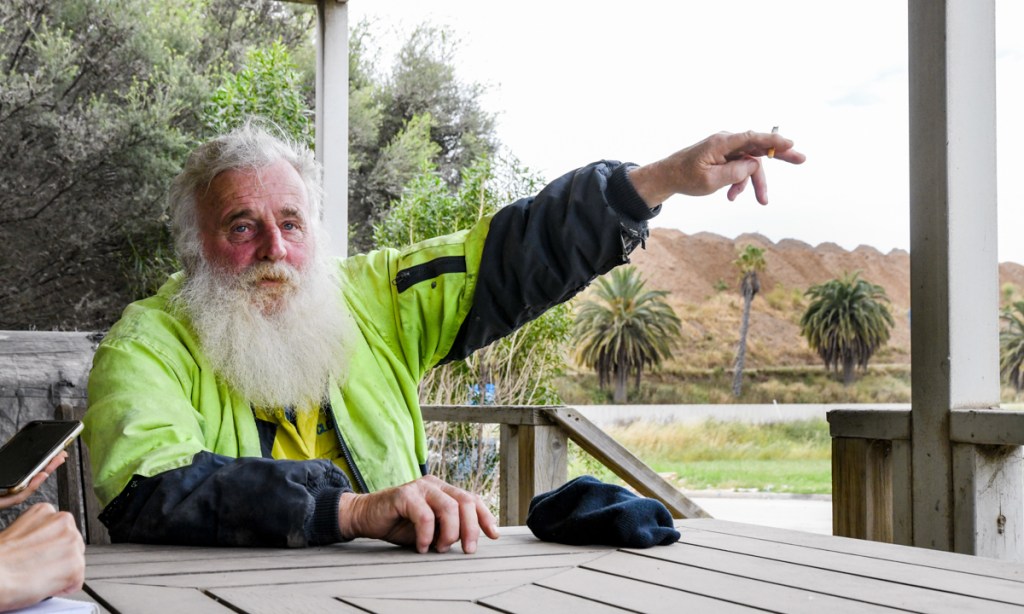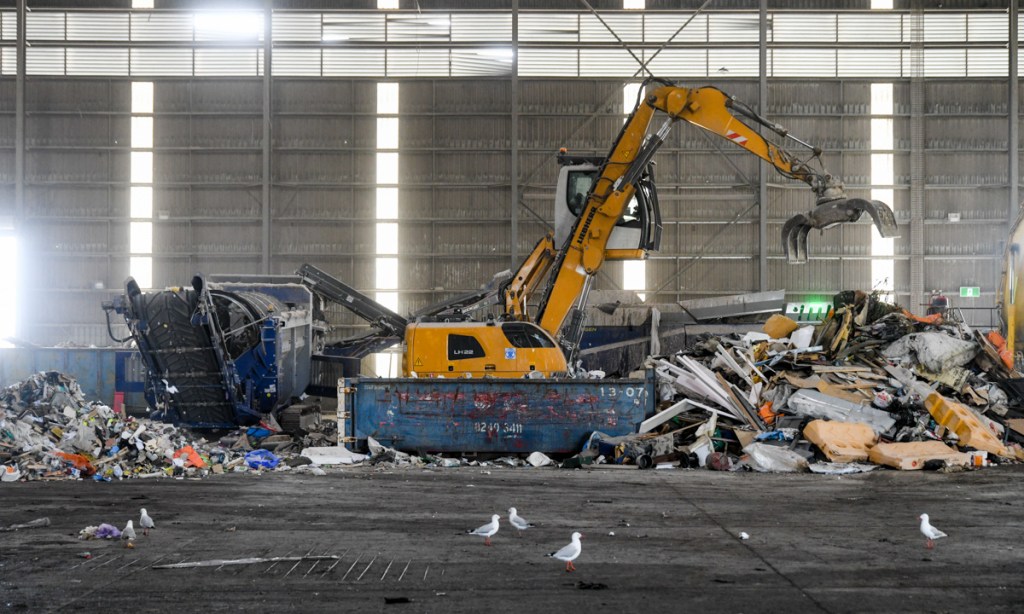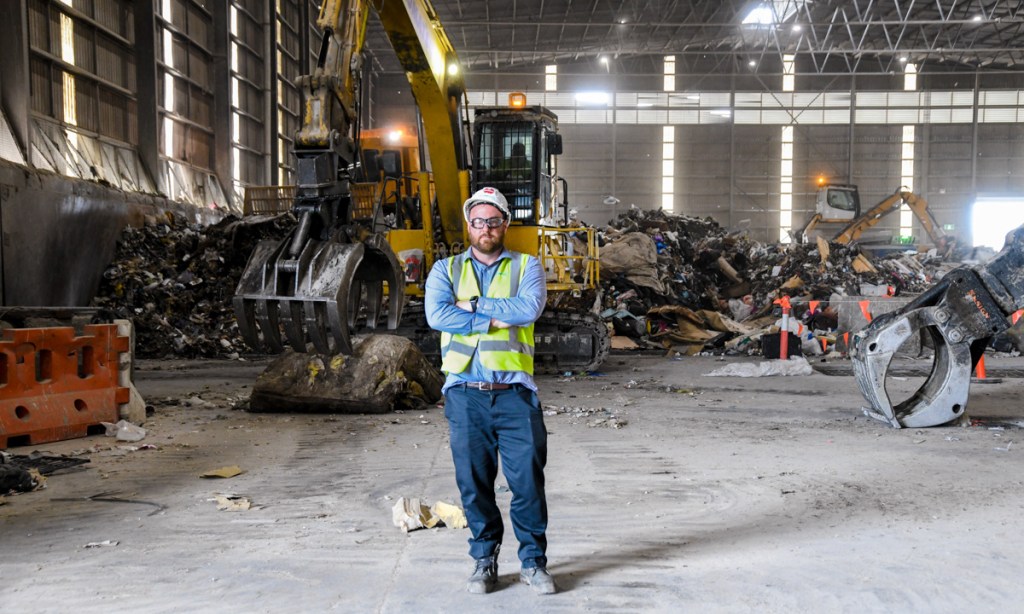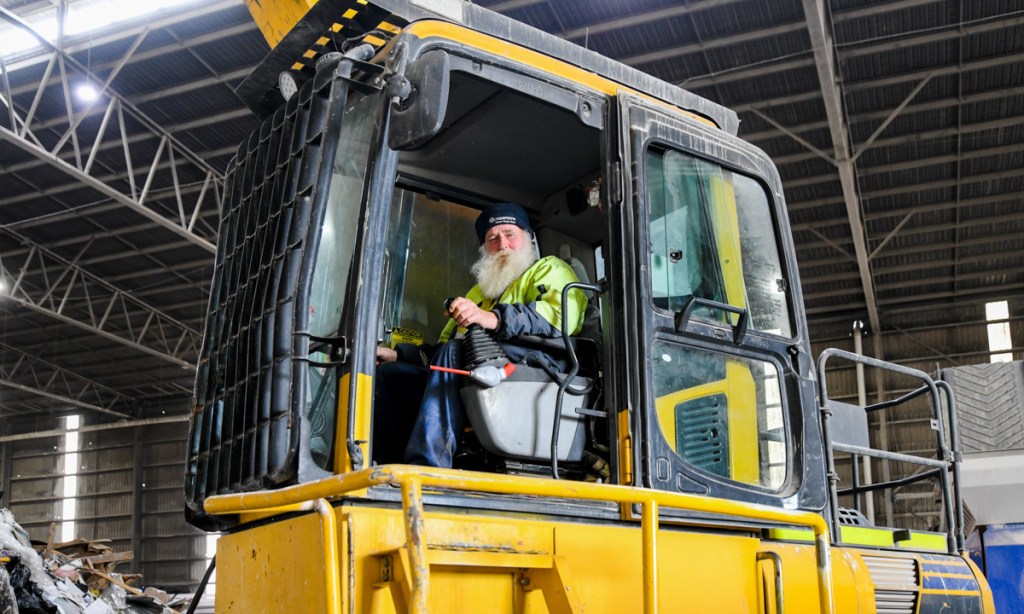A dusty, stinky site on the outskirts of the city contains mountains of our worst habits. Navigating birds, mosquitos and the malodorous aura, a team of experts process the wasteful byproducts of our lifestyles for profit.
Where there’s muck, there’s money
“Those hills, they’re all full of rubbish,” says Roy Coventry, who’s worked at Wingfield’s dump-turned-processing-facility for 30 years. “Even here right now, we’re sitting on about three metres of demolition-type rubbish. A lot of concrete, a lot of timber.
“The old frame of mind was to stamp it, put it in the ground and bury it – quickest, easiest, cheapest.”
Sitting at a timber table overlooking 94 hectares of grimy, littered land, the Cleanaway plant operator – with a gruff voice and cigarette-stained beard – points to the large hills flanked incongruously by palm trees.
Although the Adelaide City Council, who established the site, filled the mountains with rubbish, they tried making them look “aesthetically nice,” Roy says. “It was meant to look better.”

Roy Coventry gesturing (with durry) to the beautified hills of rubbish
Wingfield is the physical embodiment of how Adelaide’s relationship to rubbish. We’ve come here to learn about how the site went from being a spot to bury refuse to a cluster of four companies that see waste as a valuable resource. Roy, we’re told, is the perfect person to speak to, as he’s been at the smelly coalface for decades.
As Roy gives us a Wingfield welcome, a mosquito lands on his face. “Hit it!” he says. Over the roar of trucks moving in and out of a nearby warehouse and the constant plume of red dust, we whack his cheek. The dead mosquito falls and hangs in his beard.
We ask Roy whether he’s proud of his job. “We’re all cogs in a wheel,” he says with a smile. “I was digging [burial] pits from 1989 to 2004, until it closed,” he says.
“The pits were roughly eight to 10 feet wide. They went down probably five or six metres and then they had a layer of dirt put over them. There was another layer of rubbish put over. It wasn’t dug as one level.
“But a lot of that material that used to come into the land is not coming to landfill no more.”
South Australia diverted 83.3 per cent of its waste from landfill in 2019, according to a Green Industries SA report. The state’s scorecard, however, hasn’t always been so glowing. In 1878, before human waste was separated from general rubbish, there were roughly 7000 cesspits in the city. Back then, Karrawirra Pari River Torrens was also the dumping ground for a variety of commercial schlep, with Adelaide’s western park lands used as postcode 5000’s principal tip.
Fast forward 144 years and we now have three bins for household waste. If you’re on the Cleanaway council collection circuit, or hire a skip from a company that drops its waste here, you’re contributing to the 550 tonnes of processed trash at the Cleanaway Wingfield transit facility every two days.
In the warehouse, tradies like Roy sit in earth-moving machines and control gigantic claws to pluck out hard-to-process materials, such as steel rods and carpets. Navigating around swooping seagulls and rats, drivers in top-loaders – which station manager Stephen Mulholland describes as a “tractor with a bucket on it” – crush the waste.
Piles of pulverised matter are then shoved into a hole by an excavator, where one of the 15 daily trucks waits below to accept the rubbish and drive it 55 minutes north to Inkerman. At the tip, the garbage will take 40—50 years to break down.
Roy knows about the tropes that come with his work. “They say a rubbish dump smells and whatnot, and, well, yeah – there are loads of smells. And it gets covered every night,” he says.

Wingfield’s transition from dump to transit facility began in the 1950s. At that time, the Adelaide City Council wanted to take all its refuse and move it out of the Park Lands. It had its sights on a council-owned 16-hectare site abutting a marshy reserve 13 kilometres north of the city. The area, located in Wingfield, was going to solve the city’s growing waste problem. It was also far away from ratepayers’ noses, and would therefore draw fewer complaints. The council subsequently bought more land and expanded the site.
But in the 1980s and 1990s, a series of reports commissioned by the council and state government highlighted there was no legislation defining what a landfill site is. In 1999, the Wingfield Waste Depot Closure Act came into effect, ordering the closure of Wingfield by the Corporation of the City of Adelaide by 2000 (though the deadline was later extended to 2004).
“The landfill didn’t actually finish here ’til 2004,” Roy says. “Some guys lost their job and others got a job with the new company that was taking over, because the facility was run by the Adelaide City Council back in those days.
“When landfills left the metropolitan area, this was the last one to still be open.”
The Environmental Protection Agency was established in 1995 and air, water, waste and noise quality was then covered in a single Act. Roy says “a lot more recycling” began to take place at the waste facility.

Two years ago, the State Government unveiled its South Australia Waste Strategy 2020-2025. The plan outlines the ambitious aim of sending “zero avoidable” waste to landfill by 2030. It also has a nifty waste management hierarchy, with “avoid” at the top and “dispose” at the bottom. “Litter and marine debris” dumped on land and in the ocean is the least preferrable option for waste management, it states.
The plan also outlines the former government’s desire to improve the commercial landscape for reusing resources. “We can increase market confidence for investments in the circular economy, resource recovery and waste management,” the report says.
Stephen Mulholland, who worked in steel manufacturing for 20 years before making the switch to rubbish in 2021, shows us a mammoth pile of mattresses in the corner of the dusty Cleanaway warehouse. “Mattresses,” he says. “What can you do with mattresses? Not much.”
Mattresses are stubborn. But businesses such as Cleanaway are finding the value of these objects in their innards. They are stubborn in their pursuit of finding a solution. “We’ve got a high-speed shredder that shreds them,” Stephen says. “You get the bits of steel out and then all the fluffy stuff goes into landfill. It’s a very time-consuming process, but over the road is ResourceCo and they come in, collect it and turn it into something else.”

Stephen Mulholland
We go back to Roy at the timber table and ask how much longer he’ll be working here.
While lighting another cigarette, he says he resigned a couple of years ago when his partner passed away, but like the seagulls that swoop in looking for tasty treats, he was pulled back with the lure of casual work – something that’s always available in this industry, he says.
Considering his lifetime of working in waste, we ask if Roy remembers the day he stopped smelling the odour emanating from the rotting rubbish.
“I haven’t been able to smell anything for ages,” he says, winking. “Are you wearing perfume?”





